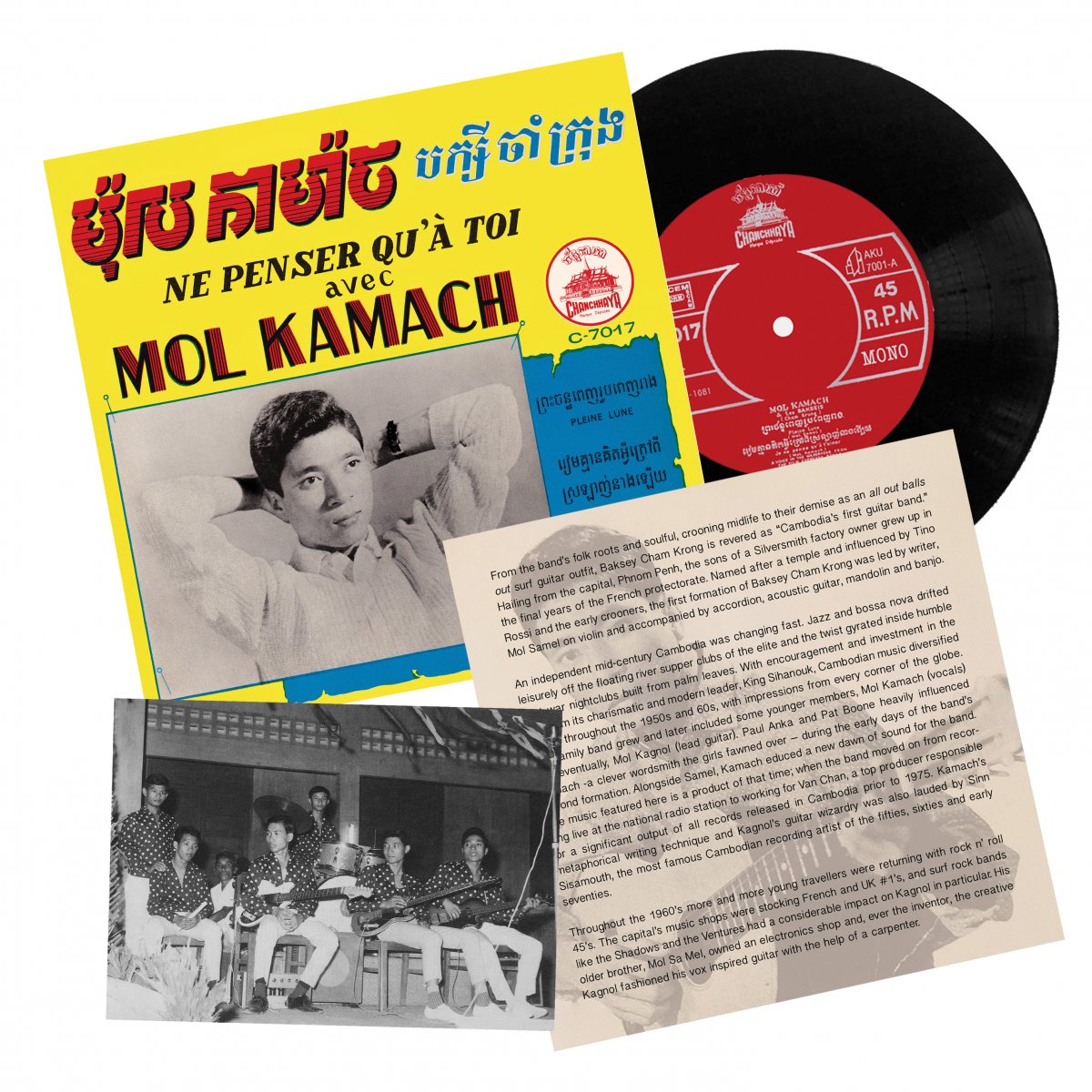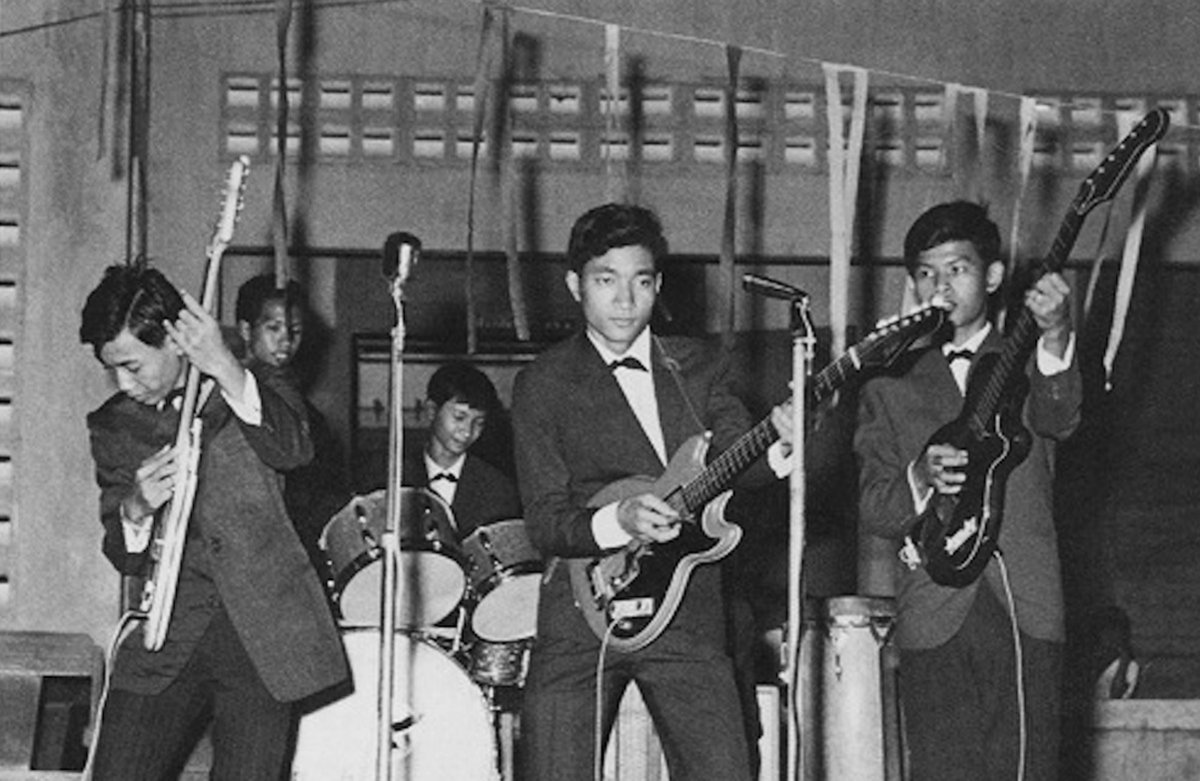Ne penser qu'à toi
3,90€ - Buy Digital 7,90€ - Buy Vinyl 12,90€ - Buy bundle Mol Kamach 44,90€ - Bundle "Khmer Special"
Cambodia's first guitar band officially reissued for the first time with identical artwork, postcard and exclusive liner notes. (includes digital version)
Whereas most of the original recordings disappeared during the Khmers Rouge era, this single bring back to us the Cambodian musical scene of the 1960s.
For the first time two single records of Baksey Cham Krong - the first Cambodian guitar band - are officially being reissued in an identical version. Between surf music and ballad, these two records released in 1963 and 1964 are an invitation to rediscover the effervescent Khmer musical scene of the 1960s.
The early 1960s are often described as the “golden age” of Cambodia, with a flourishing economy and a strong cultural development. As the country had just won its independence, the King Norodom Sihanouk - who had been a singer himself (see below) - encouraged dynamism and creativity in all aspects of cultural life.
In 1959, in the midst of this artistic turmoil, Mol Kamach and his brothers created a band: the Baksey Cham Krong (also spelled Bakseis Cham Krung) named after a temple of the Angkor site. The teenagers were influenced by the latest hits they had listened on the radio. For the music, Kagnol got his inspiration from the rock n’ roll of the Ventures and the Shadows while Kamach took over the vocal techniques of crooners such as Paul Anka. The lyrics were either in French (as for the song Ne penser qu’à toi) or in Khmer. The song Pleine Lune became a hit and revealed Kagnol’s musical genius at playing guitar and Kamach’s delicate voice. From their beginnings on the capital’s high school stages to their first broadcasts on national radio, the success of the Baksey Cham Krong was very quick. At the end of the decade the band already split, the brothers getting back to activities that conformed more with their parents’ expectations.
A few years later, in April 1975, the arrival of the Khmer Rouge in Phnom Penh put an end to this musical development and started the darkest era of Cambodia’s contemporary history. A quarter of the population was killed in the Khmer Rouge genocide and the majority of artists and intellectuals were exterminated in a sordid will to wipe out any form of culture in the country. Films and music were banned, movie tapes and vinyls were destroyed. Mol Kamach and Mol Kagnol luckily managed to flee the country: one now lives in France, the other in the USA. Both still continue to make music nowadays.
Bearing witness to the past history, the reissue of these two single records of Baksey Cham Krong brings back to us the Cambodian musical scene of the 1960s.
Première réédition officielle et à l’identique de deux 45 tours de Baksey Cham Krong, le premier groupe rock au Cambodge. Entre surf music et ballades folk, ces deux disques sortis en 1963 et 1964 sont une invitation à redécouvrir la bouillonnante scène musicale khmère des années 1960.
Souvent décrit comme l’« âge d’or » du Cambodge, le début des années 1960 est marqué par une économie florissante et un fort développement culturel. Le pays vient de gagner son indépendance, et à sa tête, le roi Norodom Sihanouk, qui fut lui-même chanteur à ses heures (voir ci-dessous), encourage un dynamique et une créativité dans tous les domaines de la culture.
En 1959, dans cette effervescence artistique, Mol Kamach et ses frères montent un groupe : les Baksey Cham Krong (ou Bakseis Cham Krung) du nom d’un temple du site d’Angkor. Les adolescents sont influencés par les derniers succès entendus à la radio, pour la musique, Kagnol s’inspire du rock n’ roll des Ventures et des Shadows, au chant, Kamach reprend les techniques vocales de crooners comme Paul Anka. Il chante soit en français (comme dans le titre Ne penser qu’à toi), soit en khmer. Le tube Pleine Lune fait un tabac à l’époque et révèle le génie musical de Kagnol à la guitare et les subtiles envolées de Kamach au chant. Des débuts sur les scènes des lycées de la capitale, aux apparitions à la radio nationale, les Baksey Cham Krong connaissent un rapide succès. A la fin de la décennie le groupe se sépare déjà, les frères retournent à des activités plus conformes aux attentes de leurs parents.
Quelques années plus tard, l’arrivée des Khmers rouges à Phnom Penh en avril 1975 sonne le glas de cet essor musical, et le début des plus sombres années de l’histoire contemporaine du Cambodge. Dans le génocide perpétré par les khmers rouges un quart de la population meurt, et la majorité des artistes et intellectuels sont exterminés dans une volonté sordide d’éradication de toute forme de culture. Les films et la musique sont interdits, les bandes et vinyles détruits. Par chance, Mol Kamach et Mol Kagnol réussissent à fuir le pays, l’un vit aujourd’hui en France et l’autre aux Etats-Unis. Ils continuent tous deux à faire de la musique.
Pensées comme des objets témoins d’une histoire révolue, ces deux rééditions de 45 tours de Baksey Cham Krong ressuscitent la scène musicale cambodgienne des années 1960.
60Sカンボジアン・サーフ盤が新装アートワークで正規7"アナログ・リイシュー!
Originally released by CHANCHHAYA in 1964.
Licensed by MOL KAMACH & MOL KAGNOL.
Liner notes by Dee Peyok
Martin Jay, Fabrice Géry & Mol Kamach holding the brand new reissues!






